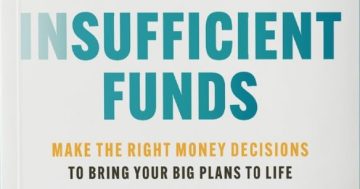Nicole Webb* says nearly one in two Australians admit to living from pay cheque to pay cheque and shares small steps to help people get out of the rut.
 Living lean? You’re not alone. Nearly one in two Australians admit to living from pay cheque to pay cheque.
Living lean? You’re not alone. Nearly one in two Australians admit to living from pay cheque to pay cheque.
Worse, more than 5.9 million working Aussies say they are unprepared to cope with a job loss, admitting they couldn’t survive financially for more than a month if they unexpectedly lost their job or could no longer work.
Whether you fall into this bucket or not, here are a few ways to reclaim your money confidence, get a leg up and take control of your financial future.
- Determine what you want
One of the best ways to break the cycle of living week to week or month to month is to clarify what you want.
Concreting your goals and objectives can give you purpose and encouragement, making it more likely you’ll achieve what you want.
Without goals, it can be really hard to develop good financial habits.
We think that with a bit of visualisation and proper planning you can begin to build your long term money confidence.
- Draw up a budget
Once your goals are bedded down, it’s time to draw up a formalised plan to help you stay on the right path.
You might have a fair idea of what your outgoings are but unless they’re noted down, you won’t know for sure.
You can use your online banking app or a recent bank statement to confirm your regular outgoings.
And be sure to also account for variable expenses too.
Variable expenses can be a bit trickier to spot, as they can come up only from time to time. They’re things like after work drinks, one-off dry cleaning bills, coffees and birthday gifts.
Try using a rough estimate to help you to pad your budget and ensure those items are captured.
Here you can also make a plan of how much to sock away into regular savings.
When it comes to budgeting, it should feel like a stretch (you don’t want it to feel easy), but it shouldn’t be unsustainable.
- Trim the fat
Once you have drawn up your budget and have oversight of your regular outgoings, you can see where there’s fat to trim.
Maybe you have a family Spotify subscription but only use one account. Or maybe you have unloved health memberships languishing in your wallet.
Or perhaps there are other services or subscriptions you no longer need?
Now is the time to cut those items loose and claim back those savings.
- Beef up your emergency fund
You’re probably a budget pro by now and have slashed the fat and are running on the financial treadmill. So, now it’s time to future-proof your finances.
An emergency fund can be the ticket to buying yourself peace of mind, financial independence and maybe even the ability to sleep better at night.
Your emergency fund is prescribed money you set aside for a rainy day.
These are generally for unexpected emergencies like sudden medical expenses, if the water heater breaks or you fall on hard times.
Having an emergency fund means you are more likely to cope if and when bumps in the road come up, and you can continue to fund your day to day expenses without relying on family and friends.
- Protect your earning potential
While your emergency fund can give you assurance for short- to medium-term needs, income protection can give you long-term or lifetime assurance.
It helps protect your biggest asset — you — and your ability to earn an income
No one plans to get sick or become injured.
But if you do, and you find yourself in the unfortunate position of not being able to return to work in the long term or even at all, income protection pays a proportion of your pre-injury/illness income for a specified time.
You might think of income protection as a way to protect your lifestyle.
Imagine if you could no longer earn an income, how would you continue to fund your lifestyle? Or would you need to scale back and live more modestly?
By having insurance in place like income protection, it can help protect your lifestyle financially. And this sort of peace of mind can be invaluable.
It’s especially handy if you are self-employed or the main breadwinner.
This way you can have confidence you can continue to pay all your bills and focus on your return to wellness.
If you’re considering income protection, it might also be a good time to think about other types of life insurance you might need to protect your lifestyle, such as total and permanent disability cover and life cover.
*Nicole Webb is a contributor at Spaceship.
This article first appeared at spaceship.com.au











